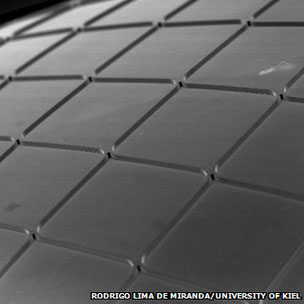 |
Small alloys have experienced 10 million repeated recovery.

The material was cut into thin dog bone shapes for stress testing.

The small new alloy has an area of ​​1 square centimeter and is very thin.
Beijing time on June 9 news, according to foreign media reports, scientists have developed a new type of alloy that can still be restored to its original shape after repeated bending 10 million times. The new alloy consists of nickel, titanium, and copper, which breaks the previous record of repeated conversion of the memory alloy. It is very flexible and has many potential uses, such as prosthetic heart valves, aircraft parts or a new generation of solid-state refrigerators. Research on new alloys has been published in the journal Science.
Although before the advent of new alloys, memory alloys have been used in areas such as surgery. For example, vascular stents are squashed before they are implanted in the human body, and they are returned to the design shape to support blood vessels after being implanted in the human body. However, these memory alloys have never fully achieved the desired effect, and they have not become "high-cycle fatigue" applications.
The main researcher of the new alloy, Professor Manfred Wuttig of the University of Maryland in the United States, told the BBC: “Such as shape memory alloys for minimally invasive surgery, the memory alloys can be restored one or more times, but the number of recovery is very limited. The new material discovered this time Unusually, it can be called a leap."
Prof. Wuttig and colleagues at the University of Kiel in Germany developed a new alloy. The crystal structure is the key to the outstanding properties of new alloys. The arrangement of nickel, titanium and copper atoms in the new alloy allows them to switch between two different arrangements. This transition is called "phase change" and is the reason why the alloy recovers its shape before bending. "Phase change" can occur either when the temperature changes or when the tension is released.
Scientists pointed out in the paper that titanium and copper formed Ti2Cu simplifies the conversion process. Professor Wuttig said: "This special precipitate is fully compatible with two different crystal structures, so it guarantees to a certain extent that the alloy can be completely converted from crystal structure A to B and then converted back to A."
The team made a small piece of alloy with an area of ​​only 1 square centimeter, less than 1 millimeter thick. Ten million cycle tests were completed under thermal conditions and pressure conditions, respectively. Stress testing is not difficult and automated testing can be achieved simply by purchasing or building a small stress-strain machine. The heat test is very difficult. The scientists used a special furnace equipment to quickly complete the 10 million heating and cooling of the sample. Each test takes a lot of time.
Scientists use powerful microscopes and x-rays to examine the changes in alloy crystal structure. Professor Wuttig explained: "We did experiments in synchrotron and x-rays will tell us about the specific crystal structure."
Prof. Richard James of the University of Minnesota, in his review article, used "breakthrough" to describe 10 million repeated conversions. Professor James was involved in the development of a previous memory alloy that could only be switched back and forth approximately 16,000 times.
The study was also praised by Professor John Huber, a material expert at the University of Oxford: “This is an important finding. The general shape memory alloy shows a noticeable decrease in performance after few conversions. Ten million cycles The lower limit of the material requirements, the new alloy really achieves high cycle fatigue, and it has potential application value in quite a few areas.†Professor Huber believes that the new alloy can be used for aircraft flaps or “control surfaces†and can also be used for spacecraft solar energy. The deployment of the panel and the prosthetic heart valve.
Professor Wuttig and his colleagues are particularly interested in refrigeration. Professor Wuttig explained: “Refrigerator compressors compress and expand liquids through “phase change,†and the alloy's record-breaking “endurance†makes it possible to replace liquids.†(Wish)
Sodium Hexametaphosphate (NaPO3)6,white powder-like crystal or transparent glassy crystal, density is 2.484(20),easily soluble in water,but not in organic solution,absorbent to dampness,and turn sticky when absorbed dampness in air.it is possible to form solvent compound with metallic ions such as Ca,Ba,Mg,cu andfe;it is affine agent for Water Treatment.
Sodium hexametaphosphate (SHMP) is a hexamer of composition (NaPO3)6.Sodium hexametaphosphate of commerce is typically a mixture of polymeric metaphosphates, of which the hexamer is one, and is usually the compound referred to by this name. Such a mixture is more correctly termed sodium polymetaphosphate.
SHMP is used as a sequestrant and has applications within a wide variety of industries, including as a food additive in which it is used under the E number E452i. Sodium carbonate is sometimes added to SHMP to raise the pH to 8.0–8.6, which produces a number of SHMP products used for water softening and detergents.
A significant use for sodium hexametaphosphate is as a deflocculant in the production of clay-based ceramic particles.It is also used as a dispersing agent to break down clay and other soil types for soil texture assessment.
It is used as an active ingredient in toothpastes as an anti-staining and tartar prevention ingredient.
As a food additive, SHMP is used as an emulsifier. Artificial maple syrup, canned milk, cheese powders and dips, imitation cheese, whipped topping, packaged egg whites, roast beef, fish fillets, fruit jelly, frozen desserts, salad dressing, herring, breakfast cereal, ice cream, beer, and bottled beverages, among other foods, can contain SHMP.
Sodium Hexametaphosphate
Shmp 68%,Sodium Hexametaphosphate,Shmp For Paint,Shmp Sodium Hexametaphosphate
Yucheng Jinhe Industrial Co.,Ltd , https://www.jinhetec.com
